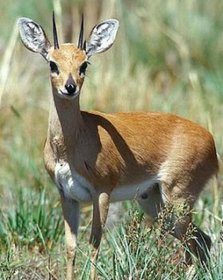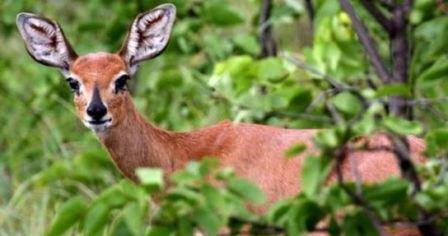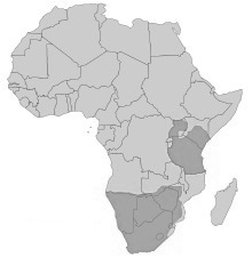SteenbokRaphicerus campestris |

Custom Search
|
|
The steenbok (Raphicerus campestris) is a fairly common small African antelope found in 2 distinct populations, one in East Africa and the other in Southern Africa. The species is sometimes known as the steinbok or steinbuck.
The steenbok inhabits a wide variety of habitats from open plains, open woodland and thickets, stony savannah, open grassland or even semi-desertic areas. The steenbok is usually active throughout the day, however during hotter periods, they will find shades to rest under. There is some variation in their coat ranging from a light tan to reddish-brown, some individuals are more grayish while others rather orange to reddish. The steenbok is a small species with long legs and an upright stance. Adults measure only 70 to 95 cm in length and stand 16 to 24 inches (45-60 cm) at the shoulder. They weigh anywhere from 7 to 16 kg. The ears are extremely large, both males and females display conspicuous black pre-orbital glands in front of their large, dark brown eyes. The steenbok underside, including chin and throat, is white, as is the ring around their large eyes. Only males have horns, these are straight, parallel, smooth, sharp, very upright, and 7 to 19 cm long. If feeling threatened they will try to stay hidden by lying on the ground and freezing until they feel safe. But if a predator gets too close the steenbok will try to run away, at least for a short distance and then try to hide again. They are preyed upon by many animals including leopards, caracal, martial eagles, African rock pythons and African wild cats. Younglings are hunted also by other smaller predators such as jackals, raptors, monitor lizards, and baboons. The Steenbok is believed to live for 7 years or even more in the wild.
Species / Taxonomy
Over time up to 24 subspecies have been described by scientists, based on such features as small differences in coat color, but almost all were never widely accepted. Today 2 subspecies are recognized by taxonomists. R. c. campestris - Found in Southern Africa occurring in Mozambique, Angola, Namibia, Swaziland, South Africa, Botswana, Zimbabwe, Zambia and most likely Lesotho. R. c. naumanni - Found in East Africa, this subspecies occurs Tanzania, central and southern Kenya and it is now probably extinct in Uganda. Diet / Feeding Since the Steenbok is a small animal it will usually graze around the low-level vegetation. They feed on forbs, grass sprouts, woody plants, shoots, young leaves, flowers and fruits, but will also scrape up roots and tubers. Unlike other antelope species like the blesbok, they seldom need to drink water, since they get most of the water they need from the food, some are found as far as 80 km from permanent water sources. Reproduction The steenbok is typically a solitary animal, except when they come together to mate. Males become sexually mature at about 9 months and females a little earlier at 6 to 8 months. Usually a monogamous pair will remain in the same area or territory even though they live independently, but still aware of each other through scent markings. Their territories range from 0.4 up to 1 km square, and are marked by both using dung middens or dung hills. Males become more aggressive during the female's oestrus, and rival males will engage in "bluff-and-bluster" type displays. The breeding takes place all year round, but more calves are born in the spring and summer from November to December. Sometimes females may breed twice in a year. The steenbok gestation period last about 170 days, and usually a single calf is born, sometimes 2, weighing around 2.2 lbs (1 kg).They can stand and walk almost immediately and begin to feed from their mother just minutes after birth and are weaned at 3 months. Even so fawns remain hidden from predators in the first weeks of their life, usually concealed in vegetation or in old aardvark burrows. During this period the mother only contacts with the calf is in the early morning and evening to feed it, at 2 weeks old the young steenbok begins to eat grass. Conservation status and major threats The steenbok is listed as a "Least Concern" species since it's considered widespread and relatively common and there are no major threats to it. The species is not listed in CITES. Still steenboks, juveniles in particular, are vulnerable to predation by domestic dogs and herdsmen who frequently capture and kill them. But unlike many African wildlife, the steenbok has at least in some cases benefited from human presence. Their population trend is considered generally stable or increasing and estimated in excess of 600,000 animals.
|
Scientific classification
Kingdom: Animalia Phylum: Chordata Class: Mammalia Order: Artiodactyla Family: Bovidae Subfamily: Antilopinae Tribe: Neotragini Genus: Raphicerus Species: R. campestris Subspecies R. c. campestris R. c. naumanni |



